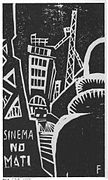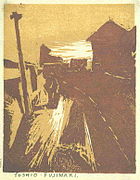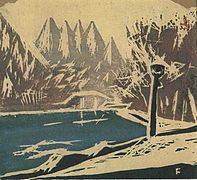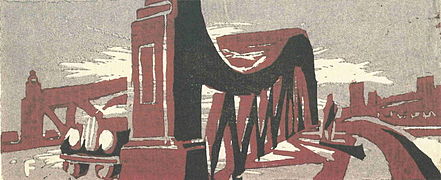Fujimaki Yoshio
Fujimaki Yoshio ( Japanese 藤 牧 義夫 ; born January 29, 1911 ; missing since September 2, 1935 ) was a Japanese woodblock print artist in the Sōsaku-hanga style.
A short life
Fujimaki Yoshio was born in Gumma Prefecture, the son of a teacher. He started drawing in elementary school. He was ten years old when he painted the Crown Prince, who was returning from a visit to England, in a watercolor on newsprint, which caused a sensation at school. At thirteen he received an award for his woodcut of the god of fortune Daikokuten . When his older brother died in 1927, he had to look after the family at the age of sixteen. That year he went to Tokyo. Inspired by Hiratsuka Unichi's "Technique of the Woodcut" ( 版画 の 技法 , Hanga no gijhō ) he turned to the woodcut.
In 1931 he was able to exhibit a woodcut in the annual exhibition of the important Shunyō-kai artists' association . Another woodcut was published that year in the magazine of the Sōsaku-hanga club. In 1932 he participated in the founding of an artists' association initiated by Ono Tadashige .
He worked non-stop in 1935 but was in poor financial shape and is believed to have fallen into a depression. On September 2, 1935, he visited a friend's house, bringing with him all his drawings, graphics and his book collection and leaving them there. He then left the house and disappeared without a trace.
literature
- Edo - Tokyo Museum (Ed.): The Changing City as Depicted in Modern Woodblock Prints. Tokyo 1996.
- Kanagawa kenritsu bijutsukan (Ed.): 1930-nendai no hangakatachi. Taninaka Yasunori to Fujimaki Yoshio o chūshin toshite . 1987.
| personal data | |
|---|---|
| SURNAME | Fujimaki, Yoshio |
| ALTERNATIVE NAMES | 藤 牧 義夫 (Japanese) |
| BRIEF DESCRIPTION | Japanese woodblock print artist in the Sōsaku-hanga style |
| DATE OF BIRTH | January 29, 1911 |
| DATE OF DEATH | after September 2, 1935 |





